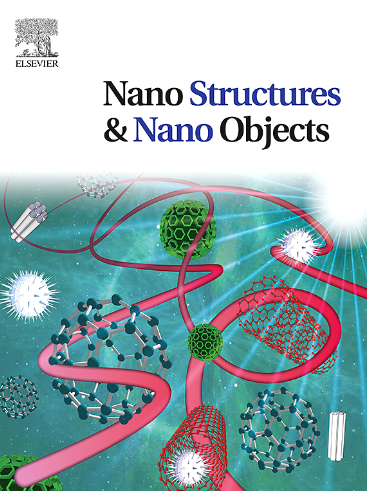Laser-assisted synthesis of metakaolin/Pd nanocomposite and its application as catalyst in wastewater remediation
IF 5.45
Q1 Physics and Astronomy
引用次数: 0
Abstract
Developing industrial activity and changing climate worldwide increase water contaminants and reduce safe water resources. Therefore, wastewater treatment and the removal or reduction of water contaminants have become important challenges. Affordable nanocatalysts for wastewater treatment are an effective solution to overcome this problem. Fabrication of a new type of metakaolin/Pd nanocomposite (MK/Pd) facilitates the reduction of noxious methyl orange and Cr(VI). This nanocomposite was manufactured based on the deposition of Pd NPs on the MK. In this study, the MK was first synthesized through a one-step heat treatment process at -750 °C for 4 h. Meanwhile, the laser ablation of Pd target in deionized water was also applied as a fast and chemical-free technique to prepare colloidal Pd nanoparticles (NPs). The samples were analyzed using X-ray diffraction (XRD), Fourier-transform infrared spectroscopy (FTIR), scanning electron microscopy (SEM) and BET analysis. The structural investigations indicated that MK surfaces with rough platy morphology were decorated with Pd NPs with an average crystallite size of 42 nm. The catalytic performance of the MK/Pd was also investigated for the reduction of methyl orange (MO) and Cr(VI) in an aqueous medium employing sodium borohydride or formic acid. The progress of reactions was monitored using UV–Vis spectroscopy, suggesting that the as-fabricated nanocomposite delivers very rapid reduction of both Cr(VI) (45 s) and MO (400 s). Compared to MO, Cr(VI) reduced ten times faster.
偏高岭土/钯纳米复合材料的激光辅助合成及其在废水修复中的应用
工业活动的发展和全球气候的变化增加了水污染物,减少了安全水资源。因此,污水处理和水污染物的去除或减少已成为重要的挑战。经济实惠的纳米催化剂是解决这一问题的有效途径。制备了一种新型偏高岭土/钯纳米复合材料(MK/Pd),有利于有毒甲基橙和铬(VI)的还原。该纳米复合材料是基于Pd NPs沉积在MK上制备的。在本研究中,MK首先通过-750°C, 4 h的一步热处理工艺合成。同时,在去离子水中激光烧蚀Pd靶也作为一种快速、无化学反应的制备胶体Pd纳米粒子的技术。采用x射线衍射(XRD)、傅里叶变换红外光谱(FTIR)、扫描电镜(SEM)和BET分析对样品进行了分析。结构研究表明,具有粗糙片状形貌的MK表面被Pd NPs修饰,平均晶粒尺寸为42 nm。研究了MK/Pd在硼氢化钠或甲酸水溶液中还原甲基橙(MO)和Cr(VI)的催化性能。利用紫外可见光谱监测了反应的进展,表明制备的纳米复合材料可以非常快速地还原Cr(VI)(45 s)和MO(400 s)。与MO相比,Cr(VI)的还原速度快10倍。
本文章由计算机程序翻译,如有差异,请以英文原文为准。
求助全文
约1分钟内获得全文
求助全文
来源期刊

Nano-Structures & Nano-Objects
Physics and Astronomy-Condensed Matter Physics
CiteScore
9.20
自引率
0.00%
发文量
60
审稿时长
22 days
期刊介绍:
Nano-Structures & Nano-Objects is a new journal devoted to all aspects of the synthesis and the properties of this new flourishing domain. The journal is devoted to novel architectures at the nano-level with an emphasis on new synthesis and characterization methods. The journal is focused on the objects rather than on their applications. However, the research for new applications of original nano-structures & nano-objects in various fields such as nano-electronics, energy conversion, catalysis, drug delivery and nano-medicine is also welcome. The scope of Nano-Structures & Nano-Objects involves: -Metal and alloy nanoparticles with complex nanostructures such as shape control, core-shell and dumbells -Oxide nanoparticles and nanostructures, with complex oxide/metal, oxide/surface and oxide /organic interfaces -Inorganic semi-conducting nanoparticles (quantum dots) with an emphasis on new phases, structures, shapes and complexity -Nanostructures involving molecular inorganic species such as nanoparticles of coordination compounds, molecular magnets, spin transition nanoparticles etc. or organic nano-objects, in particular for molecular electronics -Nanostructured materials such as nano-MOFs and nano-zeolites -Hetero-junctions between molecules and nano-objects, between different nano-objects & nanostructures or between nano-objects & nanostructures and surfaces -Methods of characterization specific of the nano size or adapted for the nano size such as X-ray and neutron scattering, light scattering, NMR, Raman, Plasmonics, near field microscopies, various TEM and SEM techniques, magnetic studies, etc .
 求助内容:
求助内容: 应助结果提醒方式:
应助结果提醒方式:


